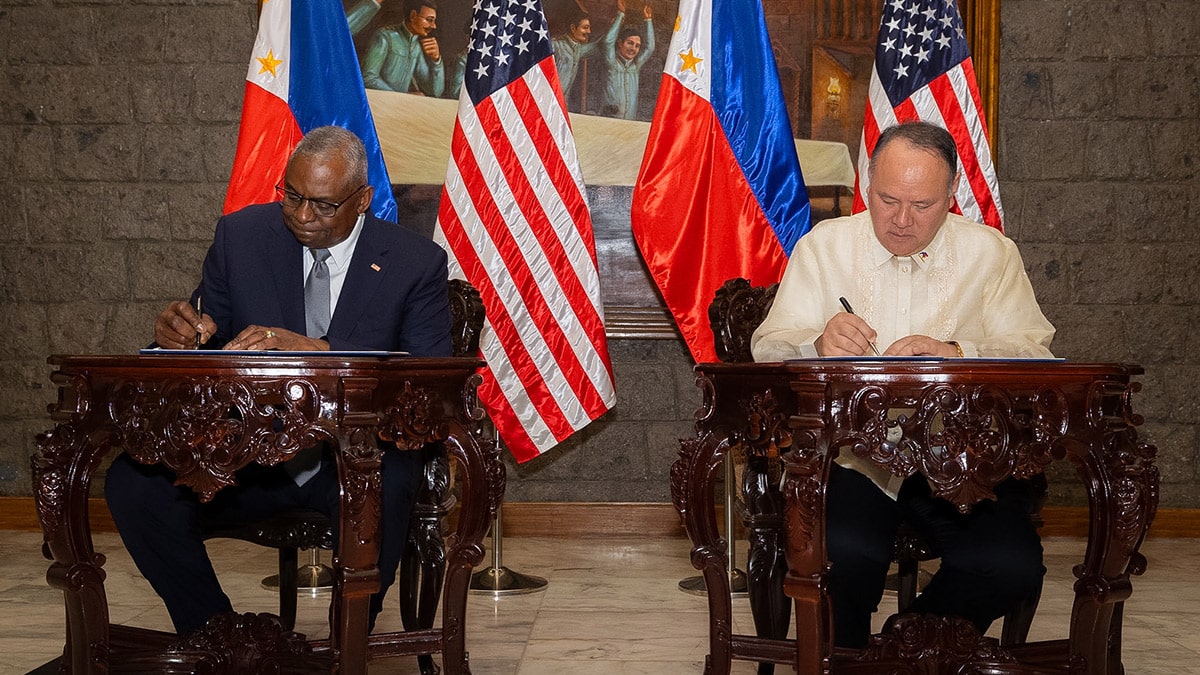
STRENGTHENING ALLIANCE Defense Secretary Gilberto Teodoro Jr. and his US counterpart Lloyd Austin III sign the General Security of Military Information Agreement at the Armed Forces of the Philippines’ headquarters in Camp Aguinaldo on Monday. The deal aims to strengthen intelligence sharing between the two countries. —Photo courtesy of US Embassy in Manila
MANILA, Philippines — The Philippines and United States signed a deal on Monday that allows the real-time sharing of highly classified intelligence and technology, further strengthening the long-running security alliance of the two countries amid shared concerns over China’s assertiveness in the South China Sea and increasingly aggressive posture toward Taiwan.
Defense Secretary Gilberto Teodoro Jr. signed the General Security of Military Information Agreement (GSOMIA) with visiting US Secretary of Defense Lloyd Austin III following a bilateral meeting at the military’s main headquarters in Camp Aguinaldo.
Austin is in Manila as part of his final trip to the Indo-Pacific region, which will include stops in Australia, Fiji and Laos. President-elect Donald Trump has chosen Pete Hegseth as Austin’s successor.
READ: WPS: US missile deployment to PH key for combat readiness – US general
“This agreement will serve as a framework to facilitate the exchange of classified military information between the Philippines and the United States,” Department of National Defense spokesperson Arsenio Andolong said during the signing ceremony.
Article continues after this advertisement
“Not only will this allow the Philippines access to higher capabilities and big-ticket items from the United States, it will also open opportunities to pursue similar agreements with like-minded nations,” he pointed out.
Article continues after this advertisement
Under the deal, GSOMIA does not expire but can be amended or suspended, if needed. The GSOMIA establishes that both countries will protect and handle classified military information to an equivalent degree of protection as required by the releasing country.
The deal also does not compel either country to share information and only facilitates faster information sharing if the need arises.
Defense alliance
Manila and Washington have been negotiating to conclude a GSOMIA since late 2021 but deadlines to finalize the deal have been pushed back several times as the Philippines worked on meeting the required security measures.
An attached agency of the US Department of Defense conducted a security assessment of selected Philippine military facilities in recent months, one of the requirements for the formalization of the military intelligence-sharing pact.
President Marcos, whom Austin also met as part of his visit, will ratify the pact for the Philippine side, a government official told the Inquirer.
Marcos, who took office in 2022, moved the Philippines closer to the United States since replacing Rodrigo Duterte, who pivoted the country’s foreign policy away from Washington and toward Beijing.
Manila has a Mutual Defense Treaty with Washington in effect since 1951 that calls for each side to come to the other’s defense in case of an armed attack.
The Philippines also has a Visiting Forces Agreement with the United States that has been in place since the 1990s, and an Enhanced Defense Cooperation Agreement that has been around since 2016.
China’s foreign ministry said on Monday no military agreement or security cooperation “should target any third party or harm the interests of any third party.”
“Nor should it undermine regional peace or exacerbate regional tensions. The only right choice for safeguarding national security and regional peace and stability is to uphold good-neighborliness and friendship and maintain strategic independence,” it added.
Guidelines
In May 2023, during Marcos’ five-day working visit to Washington, the two countries announced the adoption of the US-Philippines Bilateral Defense Guidelines.
Both sides agreed to bolster intelligence security by consulting with each other on policies, practices and procedures related to the protection of defense and military classified information and in pursuit of a GSOMIA.
In April this year, the Philippines and the United States agreed during the Bilateral Strategic Dialogue in Washington to conclude the GSOMIA by the end of 2024.
Philippine Ambassador to the United States Jose Manuel Romualdez told reporters during a press briefing that the Philippines and the United States had agreed to fast-track the long-delayed conclusion of the crucial intelligence-sharing agreement before the end of the year.
The two countries also agreed to conclude the security sector assistance roadmap by the end of the year, Romualdez said.
This roadmap of Washington’s security assistance lays out the delivery of “priority defense platforms” for Manila over the next five to 10 years.
Joint operations center
After the GSOMIA signing, Teodoro and Austin also broke ground for a new combined coordination center in Camp Aguinaldo that will facilitate the joint operations between their armed forces to respond to regional challenges.
“This center will enable real-time information sharing for a common operating picture, and it will help boost interoperability for many, many years to come. And it will be a place where our forces can work side by side to respond to regional challenges,” Austin said during the groundbreaking ceremony.
Armed Forces of the Philippines chief of staff Gen. Romeo Brawner Jr., meanwhile, described the center as “a vital nexus for our joint operations, a gateway for information sharing and strategic coordination.”
“It will enhance our ability to collaborate during a crisis, fostering an environment where our strengths combine to safeguard peace and security in our region,” he said.
On Tuesday, Austin will visit a military camp in Palawan, the island province facing the West Philippine Sea, part of the South China Sea which China claims nearly entirely, where he will observe a Philippine Navy tech demonstration showcasing T-12 unmanned surface vessels that were provided by the United States through foreign military financing. —with a report from Inquirer Research
For comprehensive coverage, in-depth analysis, visit our special page for West Philippine Sea updates. Stay informed with articles, videos, and expert opinions.
